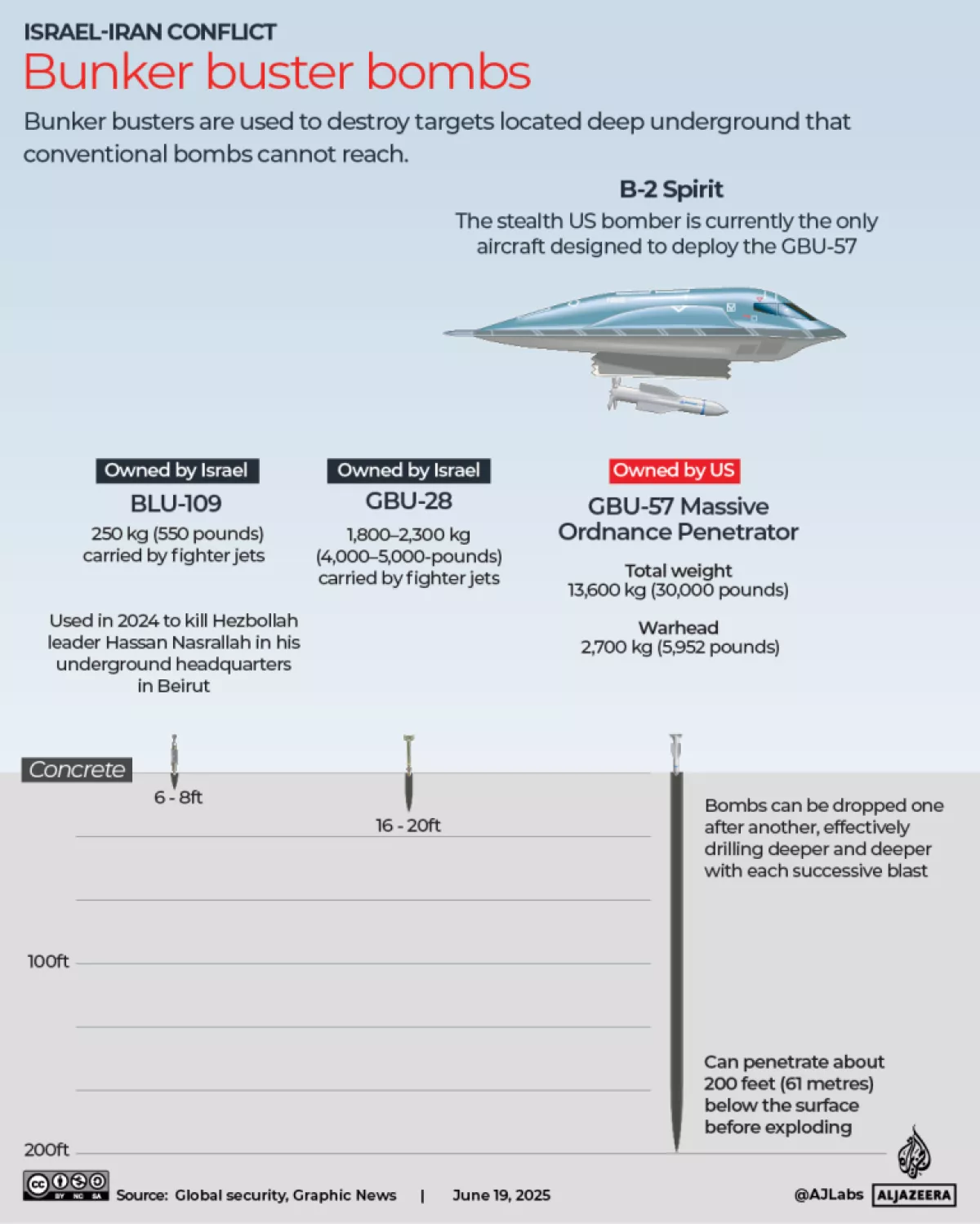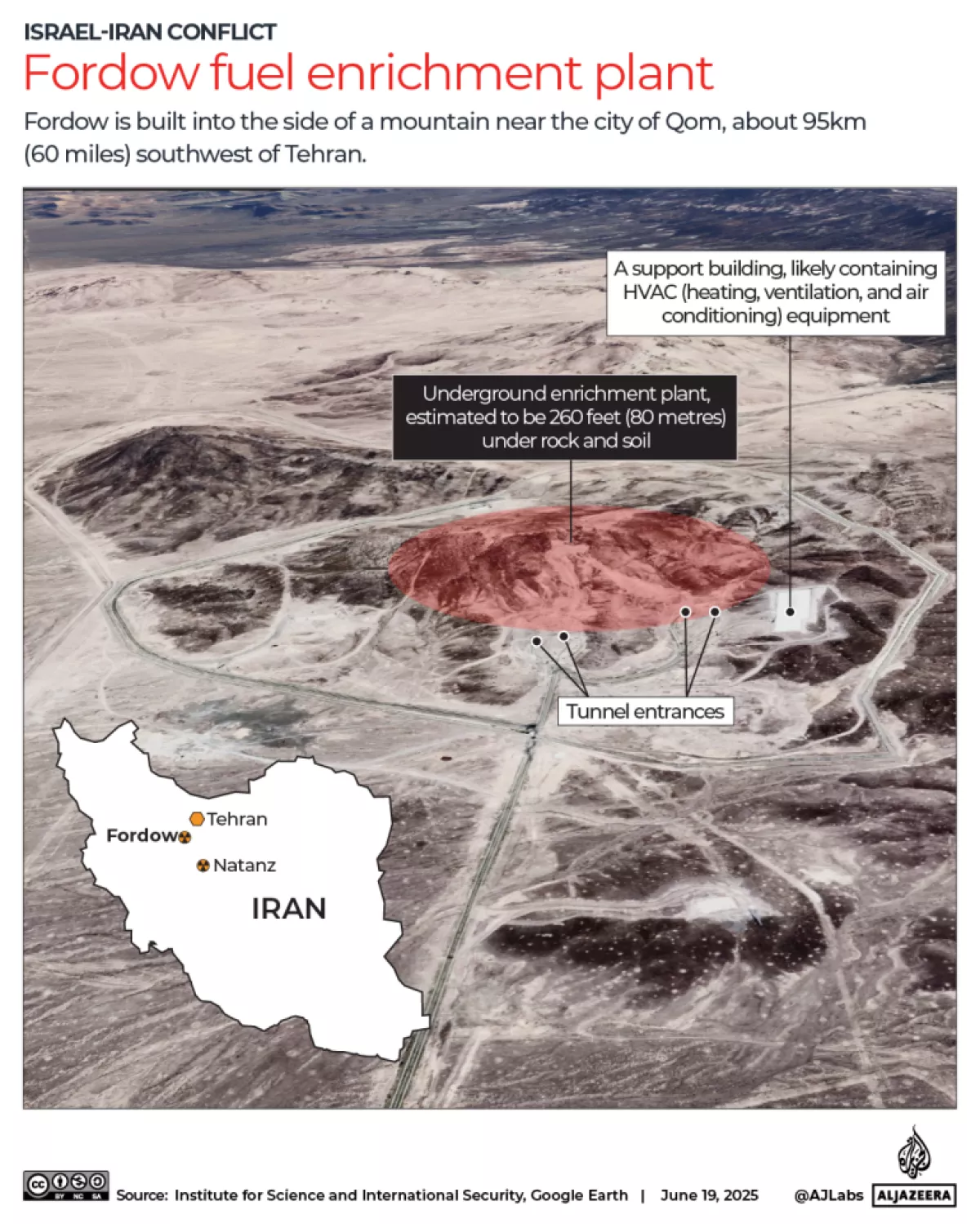Fordow – Crown jewel of Iran’s nuclear program What are environmental impacts if US ‘bunker busters’ target underground site?
As the world watches nervously for signs of broader escalation between Iran and Israel, US President Donald Trump stated on June 18 that he is still weighing his options regarding a potential US military intervention.
Speaking from the South Lawn of the White House, Trump shared with reporters that Iranian officials were now “eager” to negotiate, but issued a warning: “it’s very late to be talking,” referring to their outreach. When asked whether the US would become involved militarily in Iran, Trump, as reported by US media outlets, replied, “I may do it, I may not do it.”
Meanwhile, Iran's Supreme Leader Ayatollah Ali Khamenei dismissed Trump’s call for Tehran’s unconditional surrender. Responding to Trump's claim that his patience had run out, Khamenei warned that “any US military intervention” would come at a high cost, reiterating, that “the Iranian nation will not surrender.” Trump brushed off the defiant remarks, but once again refused to reveal any specifics. “I mean, nobody knows what I'm going to do,” he merely added.
The Wall Street Journal was the first to report that Trump told senior aides late on June 17 that “he approved of attack plans for Iran, but was holding off to see if Tehran would abandon its nuclear program.”
Iran’s heavily fortified nuclear site
Military experts and officials suggest that if the US were to strike Iran’s Fordow Fuel Enrichment Plant — a critical site in Tehran’s nuclear program — it would likely require the use of America’s 13,000kg “bunker buster” bomb.
This facility, situated roughly 32 kilometers south of Qom, Iran’s seventh-largest city, is believed to be deeply embedded into a mountain. Qom holds great religious importance for Shiite Muslims due to its many shrines, including the Hazrat-e Masoumeh, the sister of Imam Reza and daughter of Imam Musa al-Kazim.
The United States is currently the only nation with the capability to deploy such a bomb, delivered via B-2 stealth bombers. Employing it would mark a major strategic shift — from missile defence in support of Israel to direct offensive action against Iran.

“Bunker buster” refers to bombs designed to penetrate deep underground targets that conventional weapons cannot reach. The most powerful of these in the US arsenal is the GBU-57 Massive Ordnance Penetrator, a precision-guided weapon that carries a 2,700 kg warhead. Built from high-strength steel, it can burrow up to 61 meters underground before detonation. The B-2 Spirit stealth bomber is currently the only aircraft capable of carrying the GBU-57 and can carry two such bombs per mission.
Israel, too, operates US-supplied bunker busters — including the GBU-28 and BLU-109 — typically deployed from F-15 fighter jets. However, these have much more limited penetration capability and are unlikely to reach the depths of fortified sites like Fordow. According to an article by Al Jazeera, Israel reportedly used successive BLU-109 bombs in 2024 to target Hezbollah leader Hassan Nasrallah in his underground headquarters in Beirut.
How deep is Iran’s Fordow facility?
Located about 95 km southwest of Tehran, Fordow is built into the side of a mountain and is, according to Al Jazeera, believed to be situated 80 to 90 meters underground — a depth intended to withstand both airstrikes and most bunker buster bombs.
According to their sources, construction on Fordow began around 2006 and it became operational in 2009 — the same year Iran officially acknowledged its existence. Under the 2015 Joint Comprehensive Plan of Action (JCPOA), Iran agreed to halt enrichment activities at Fordow and convert it into a research facility. However, following the US withdrawal from the JCPOA in 2018, Iran resumed uranium enrichment there. While the government in Tehran insists that its nuclear program is for peaceful purposes only, the Israeli intelligence community is convinced that Fordow forms the probable heart of Tehran’s covert atomic weapons effort.

According to the Al Jazeera article, the facility is reportedly protected by Iranian and Russian surface-to-air missile systems, which may have already been targeted in ongoing Israeli strikes. Israeli Prime Minister Benjamin Netanyahu has described the campaign as one aimed at dismantling Iran’s nuclear and missile capabilities, calling them an existential threat. Officials have confirmed that Fordow is a key objective.
“This entire operation … really has to be completed with the elimination of Fordow,” said Yechiel Leiter, Israel’s ambassador to the United States, in an interview with Fox News on the first day of the strikes.
Environmental impact should a US Bunker Buster Hit a Nuclear Site
If the US were to deploy a powerful bunker buster bomb on a suspected underground nuclear weapons facility in Iran, radiation experts suggest the risk of widespread contamination is low.
“It’s a big, heavy gas molecule,” said Emily Caffrey, a health physics expert at the University of Alabama at Birmingham, explaining to the NPR publication that the gas released would likely remain localized. “It’s likely not going to travel super-far.”
She emphasized that, although it's hard to know the exact type and quantity of material stored at Fordow, any environmental release would probably not affect people beyond the immediate area.
Edwin Lyman, director of nuclear power safety at the Union of Concerned Scientists, added that the uranium isotopes typically stored in such facilities “are at the low end of hazard with regard to radioactive materials.”
“So there’s not a significant, dire health threat if those materials got released to the environment,” Lyman told NPR. “It would probably lead, at most, to a relatively low level of contamination — not zero — but probably fairly close to the site.”
However, one risk is that uranium hexafluoride gas, used in the enrichment process, can react with moisture in the air to form hydrofluoric acid, a highly toxic compound. “That is an acutely hazardous material that can harm or kill people,” said Lyman.
Still, due to the facility’s deep underground location and the design of bunker busters to collapse the mountain above, Lyman concluded, “any kind of environmental release would be relatively low since it would be essentially inhibited by this mass of rock that’s rained down on it.”
By Nazrin Sadigova








